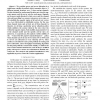Free Online Productivity Tools
i2Speak
i2Symbol
i2OCR
iTex2Img
iWeb2Print
iWeb2Shot
i2Type
iPdf2Split
iPdf2Merge
i2Bopomofo
i2Arabic
i2Style
i2Image
i2PDF
iLatex2Rtf
Sci2ools
104
Voted
INFOCOM
2002
IEEE
2002
IEEE
Power and Server Allocation in a Multi-Beam Satellite with Time Varying Channels
-- We consider power and server allocation in a multi-beam satellite downlink which transmits data to N different ground locations over N time-varying channels. Packets destined for each ground location are stored in separate queues, and the server rate for each queue i depends on the power pi(t) allocated to that server and the channel state ci(t) according to a concave rate-power curve µi(pi, ci). We establish the capacity region of all arrival rate vectors (λ1,...,λN) which admit a stabilizable system. For the case when channel states and arrivals are iid from timeslot to timeslot, we develop a particular power allocation policy which stabilizes the system whenever the rate vector lies within the capacity region. Such stability is guaranteed even if the channel model and the specific arrival rates are unknown. As a special case, this analysis verifies stability of the “Choose-the-K-Largest-Connected-Queues” policy when channels can be in one of two states (ON or OFF) and K ...
| Added | 15 Jul 2010 |
| Updated | 15 Jul 2010 |
| Type | Conference |
| Year | 2002 |
| Where | INFOCOM |
| Authors | Michael J. Neely, Eytan Modiano, Charles E. Rohrs |
Comments (0)

